As predicted yesterday, I had first light on Texas while having breakfast. Had I expected endless half-deserts with oil pumps and stately farms? Probably not, but even when deflating the stereotypes the reality turned out to be refreshingly plain:
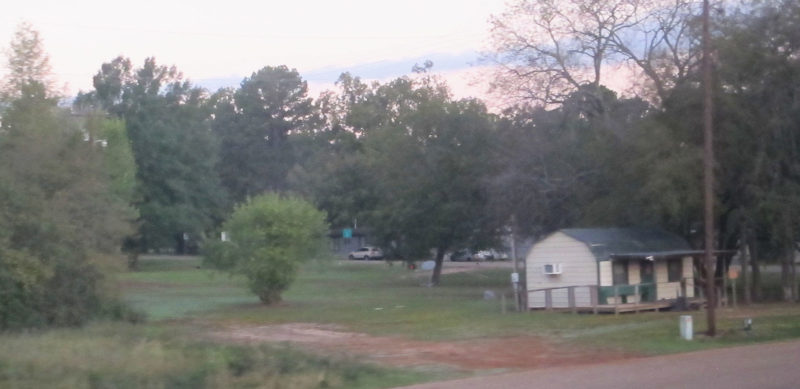
I'm sure the pairie will come soon enough, but north Texas, at least at this time of the year, clearly is a lot greener than any Texas cliché would have it. That, by the way, does not change at least until Longview, TX, which is what we are pulling out of as I write this.
Sausages and Plastic (9:00)
Speaking about the breakfast: I was a bit surprised about the staff's warning that “it all comes with a sausage”; somehow, I would have expected that vegetarians and vegans would be overrepresented on trains vs. the general population. But thinking again, that would quite certainly not be true for the sleeper car, if only because of the anticorrelation of age and money on the one side and opting out of meat on the other. Pierre Bourdieu would have loved to investigate this.
But then for yesterday's dinner, they had an explicitly vegetarian option (“Kofta Kebaps” consisting of ”Plant Based Protein”). It was easy enough to negotiate a breakfast without meat, but these days – the university canteen at home doesn't serve any meaty dish at all most of the time – a default sausage seems a bit odd. And I think if I had made the jump to veganism yet, breakfast would have been a bit of a challenge in Amtrak's cafe car.
Yesterday's Kofta Kebaps, by the way, were basically airline fare as per the 2006 Amtrak food simplification I wrote about yesterday:
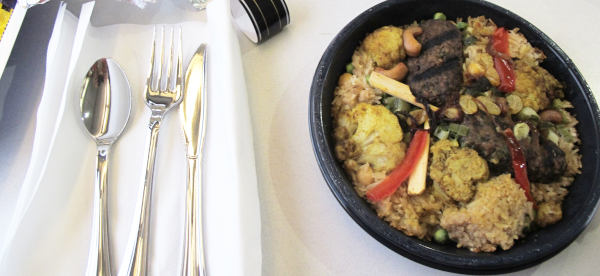
I have total sympathy for the food part; actually cooking something like this would, I agree, be an unproportional effort when you are just feeding a few dozen persons, and persons to whose individual food preferences you would like to cater to on top.
But at least for the cutlery they could have used actual, re-usable metal rather than just faking it with shiny plastic. Sure, a disposable fork does not register as far as the environmental impact of such a journey is concerned, and the occasional dishwasher run on the train would probably even add a bit to that. But it's so much nicer to have metal, and the extra effort on either machinery or staff is, I believe, negligible.
Come on, Amtrak! Even Deutsche Bahn (DB) can do it (actually, they even have proper plates). You don't want to be worse than Deutsche Bahn, do you? And don't you still have the entire lower floor of the diner car where the kitchen used to be? A dishwasher would surely fit in there, no?
Sill not stereotypical (10:00)
Here's another image with which you can stump people with strong stereotypes about Texas:
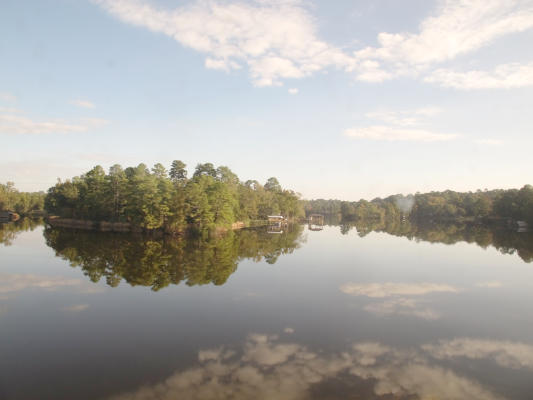
I took this somewhere near Longview, TX. We are basically still rolling through a large forest with the occasional small settlement strewn in. Only once have I seen a cattle herd, and that looked more like Allgäu than like Abilene.
It's actually a lot less lonely out here than I had expected, too, using the cellphone coverage metric. I had reason to obtain that metric because the (or at least this) Texas Eagle has no onboard Wifi and hence I'm uploading this using my own cellular data. My guess as to the reason of the lack of onboard Wifi was that they won't have a cellular connection as upstream most of the time. That may be wrong. So far, anyway, even the puny telephone inside of the carriage most of the time manages some sort of connection through which I can push a few bytes.
Hooting (11:30)
One of the major differences between a normal Deutsche Bahn ride and railway travel in the US is that US trains hoot much more, partly because in relation to the total number of crossings there are far more level crossings here, partly because I think DB trains don't hoot for level crossings secured by bars.
Against that over here the engine gives four loud hoots even for rather minor trails crossing the rail, and before passing railway crossings fairly well secured with other means, too. A little while ago, for instance, the train warned folks (and horses?) trying to cross here with four cheery hoots:
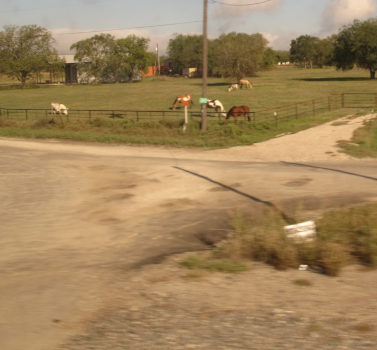
(but you notice: the general appearance of the land has changed quite a lot towards what I'd have expected Texas to look like).
I have to say that I feel some compassion for people living within, I imagine, a one-kilometre radius around such railway crossings, at least if we are talking about a reasonably busy line. For all I can tell the trains hoot all night long.
Right now, I hear these toots rather loudly, too, because the sleeper car on this train is the first car right behind the engine. Then again I have to admit that the ample hooting the train must have done overnight has not woken me (as far as I can remember).
The reason for my apparent hooting tolerance might be that I have a soft spot in my heart for another train that hoots quite often: the DB-operated local railway called the “Außerfernbahn”, connecting Kempten with the foot of the highest mountain in Germany, the Zugspitze. It (the train, not the mountain) looks like this:
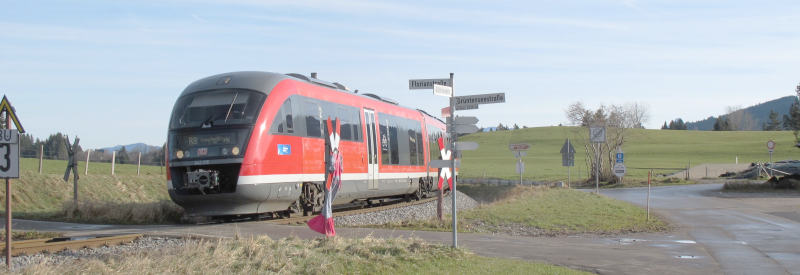
As you can see, many of its level crossings are almost entirely unsecured, and hence it hoots in rather rapid succession. But I freely confess that I love that train and its semihourly hoots in the beautiful landscape of the Allgäu. Perhaps it works like this for the people living near railways over here, too?
There's another thing that the Außerfernbahn has in common with most trains over here: It burns Diesel. On that… well, I was intrigued by a sticker on the inside of the engine-facing door or this car (lower left):
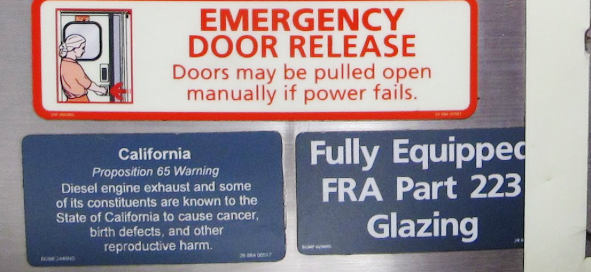
Neglecting for a moment the questions of whether Diesel exhaust is less harmful in, say, New Mexico, or whether they're putting up such a sign, too, on stuff burning wood (I mean, the carcinogenic “constituent“ here is basically soot): what does the State of California expect people to do when they see that sticker? Organise rallies demanding electrification of the major railway lines?
No mistake: I would absolutely attend one. The clouds of soot sometimes occasionally wafting by my window do not soothe my environmental qualms at all. I have to say, though, that one doesn't smell too much in the way of fuel fumes in the car. I wonder how they do that…
Crossing Tracks in Dallas, Texas and Annweiler, Pfälzer Wald (12:00)
As if fate wanted to deconstruct all my stereotypes about Texas, it was rather overcast in Dallas:
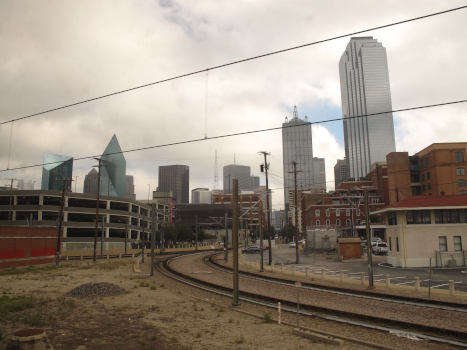
The really surprising moment there, however, was when I saw, from the dining car's top floor, that the conductor has not admonished folks to look left and right before crossing the railway track for nothing. Even the station of a big city like Dallas does not have over- or underpasses:
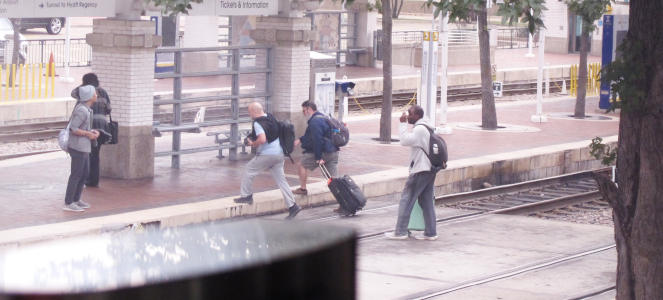
(the odd thing in the foreground, by the way, is the top end of one of the table lamps at Amtrak diner tables). By DB standards, that seems almost neck-breaking, even allowing for all the hooting US trains perform when moving in the wider vicinity of people (see above).
I'm not saying there is nothing like this on the DB network. Only recently, I have visited Annweiler, a village with the the main claim to fame that you walk through it on the way to the 20th century forging of Trifels castle. That's the one they kept Richard Lionheart in while Robin Hood was trying to raise money for his release (or was that the story?). Anyway, here's the crosswalk in that little village in the midst of nowhere:
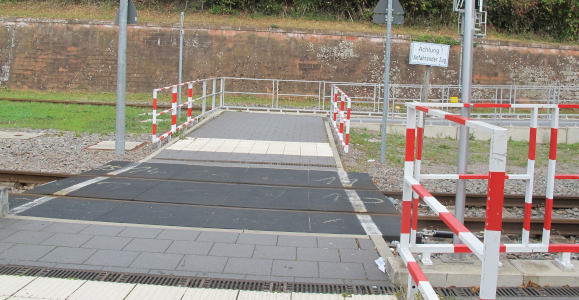
I'm not yet decided whether the nonchalant crossing in world-famous Dallas is a sign of reliance on common sense (which I would consider laudable) or just general indifference towards railway traffic (which I would obviously denounce).
Does anyone remember how people crossed tracks in major stations when railways were still the main means of long-distance transportation in the US? Did they have underpasses between different platforms back then or did people cross the tracks by stepping over the rails as they currently do? Now that I think of it: I'm not even sure when overpasses became a standard feature of railway stations in Germany. Hm… The Heidelberg station, it seems, was designed with an overpass at the latest in the 1950ies, perhaps even in the 1920ies. But was that standard in those days?
Fort Worth: Return to Summer (14:00)
The Texas Eagle receives a new engine in Fort Worth, and there's a break of about 90 minutes there. I am of course still too nervous to stray far from the train, but I did step outside and did some exploring in the station.
The most exciting part of this was the moment I left the car: It was suddenly summer again! While Chicago was cool and windy and I wore a fleece shirt and a windbreaker over my usual hoodie, the first thing I did in Fort Worth was to take off the hoodie and have a stroll in a T-shirt.
What I got to see is a station of almost European design, at least compared to the airport terminal-plus-catacomb stations I used in Boston (South Station) or Chicago (Union Station):
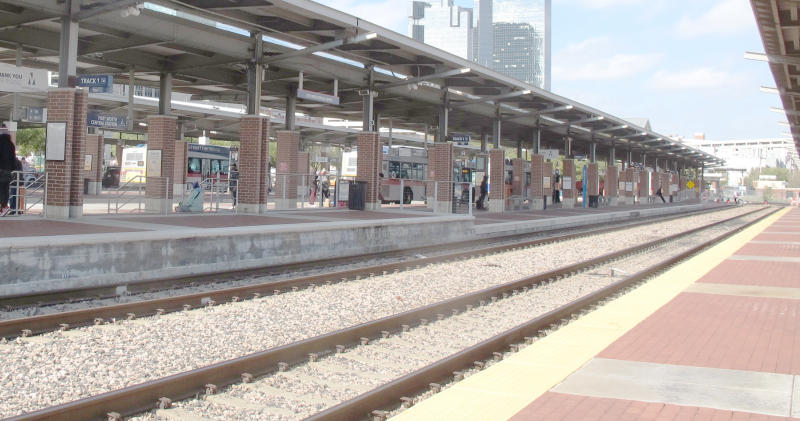
While I was out, I had a chance to have closer look at our train, which clearly has lost a few cars since we set off from Chicago:
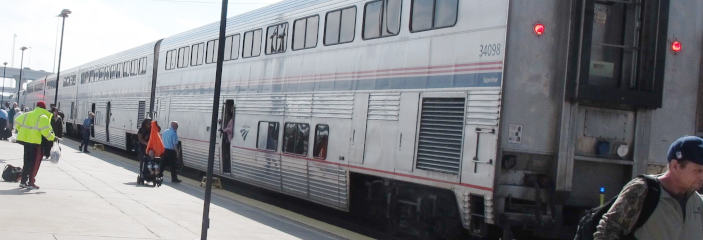
From what the end of the car facing you in that image looks like, you can probably guess what is a fairly stylish feature of these cars in the eyes of a DB user: you can pass from one “superliner” car to the next exclusively on the upper floor. This is better visible when the cars are coupled:
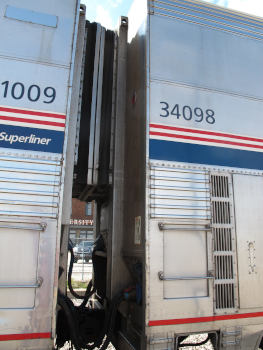
This is against DB double deckers that are coupled in what you might call an intermediate deck. At the end of each car, you ascend or descend to a platform between the lower and upper deck, from where you can change into the next car – or into the other deck. This seemed so natural to me that I never wondered whether or not that is a good idea.
On the superliners, the stairs are in the middle of the cars (at least in the sleeper cars), which to me gives them a somewhat maritime style, and saves quite a bit of space over the DB design:
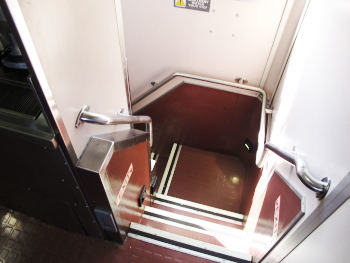
That's probably generally viable when you have baggage storage downstairs or checked baggage (as in the superliner) or your passengers use backpacks (as I do). Against that, I would not want to see people lug their huge trolley cases (which they do carry on long-distance DB trains) up such a staircase. Given the large unchecked flow of persons in and out of the DB cars as well as the lack of checked baggage options (don't get me wrong: I've never missed that), I doubt a lower-deck baggage store would fly for DB trains.
On the other hand, for a sleeper car making the lower levels dead ends is almost ideal. On the cars here, they have used that to create full-width cabins, which is a good thing for accessible cabins at the very least. And of course people don't pass through the lower-level hallways, which also is advantageous on sleeper compartments.
Now, Deutsche Bahn doesn't run any sleeper trains any more. But the Austrian railway ÖBB is currently expanding their night train network in Germany and beyond, and in case they're looking for ideas what sort of car to buy, I'd totally like the transfer-on-the-upper-deck design – and by the way, the “economy bedrooms” Amtrak has are rather nice, too. For day-and-night use, I'd prefer them over the current two-bed cabins in ÖBB night trains – except if I had to share either with another person, in which case the “economy bedrooms” would be way too small.
Time chaos (16:20)
The train schedule the staff has helpfully handed out says that we will arrive tomorrow at 6:20 pm in Tucson. That sounds great, in particular since that might let me catch a bit of the welcome reception of the conference I will attend there.
But: Which time is that? You see, tonight most of the US switches back from “daylight savings” time to their usual time zone. For me, this will happen in San Antonio, Texas, where we have a four-hour stopover anyway; the car I'm in will be joined to the westbound Sunset Limited, a train going from New Orleans to Los Angeles. That sounds simple enough.
But things become complicated once you look more closely: I'm getting off in Arizona, which does not play along with regularly manipulating the clock. So, they don't switch tonight, either. Except for the parts under Navajo government that is, but I don't think that concerns me. So… Texas has central time starting tonight (that is, UTC-6), whereas up to now they have CDT, which is UTC-7. Arizona, on the other hand is on Mountain Standard Time (that is, UTC-7, again) all year round. Sigh.
Can't we all just have UTC all year round? Would it be so bad if people in Kasachstan grew up to have lunch roughly at 17:00 (on their watches; it'd still be about noon) and people in New York had their lunch perhaps at their noon-time of about 7:00? I bet everyone would quickly get used to that. It's simpler, I maintain, than “spring forward, fall back“.
Oh, and the ticket says we'll arrive in Tucson at 8 pm tomorrow. I hope that's a worst-case estimate, or it's virtually certain that I'll see nothing of the welcome reception.
Meanwhile, Texas looks a lot more like Texas where I am now. In this image, I'm convinced the concrete platform you'll spot has held an oil pump until not very long ago:

Long Train Country (19:00)
This morning, when the first endless freight train of the day passed my window, I took this motion-blurred photo:
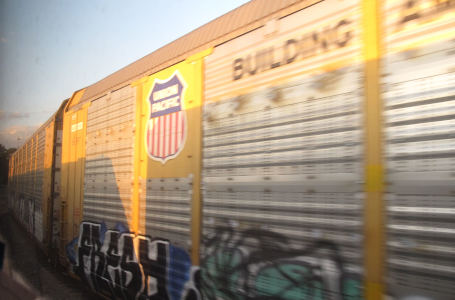
These endless and slow freight trains are a rather spectacular aspect of US railways for a European eye. You can watch them pass you for minutes, some cars carrying one 40 ft container stacked on top of another – which, I think, could push the whole contraption towards 100 tons: a 40 ft container can be up to 30 tons. I have learned today that's called a “double-stack arrangement“. You indeed will not find that in Europe with its low tunnel clearances. The car that passed me when I shot the photo above, however, is what I think is called a boxcar, but then apparently a ventilated one. The ventilation made me suspect it's a livestock transporter. I've seen a few more of those in the last few days, but I never saw what – if anything at all – was in them.
The logo on the car then made me curious – „Union Pacific“ sounds like, well, Frontier, Abilene, High Noon. The corresponding Wikipedia Page indeed says: “Founded in 1862”, although it then enumerates many other railroad companies that merged with Union Pacific, many changes of the names of the resulting conglomerates, and at least one bankruptcy.
I would hence argue that it is a matter of taste whether to identify the company running this morning's freight car with anything that had a railroad built in the Wild West, incidentally and not surprisingly again with a lot of public money. Face it: there is no railway without continuous public spending, and there's nothing wrong with public spending at all.
Well, except that if private companies are involved, it's almost impossible to avoid some pilfering, as in the case of Union Pacific's early history. Let me quote from the Wikipedia:
The original UP was entangled in the Crédit Mobilier scandal, exposed in 1872. As detailed by the New York Sun, Union Pacific's largest construction company, Crédit Mobilier, had overcharged Union Pacific; the railroad would then pass the inflated costs on to the United States government.
And no, the fault here wasn't government involvement at all.
But a few clicks from the Union Pacific page I got back on track as regards the type of car I saw this morning. Under stock cars (in a railway context), the Wikipedia has:
A traditional stock car resembles a boxcar with louvered instead of solid car sides (and sometimes ends) for the purpose of providing ventilation; stock cars can be single-level for large animals such as cattle or horses, or they can have two or three levels for smaller animals such as sheep, pigs, and poultry.
Hm. “Louvered“. I don't think I've heard that word before. The explanation, again from the Wikipedia, would be “a window blind or shutter with horizontal slats that are angled to admit light and air, but to keep out rain and direct sunshine.” If that's so, then no, this morning's freight car probably was not a livestock transporter – and there were so many more of that build over the day that it's doubtful even the US would have that much livestock to transport.
A Long Pause in San Antonio (29.42N, 98.48W, 22:00)
We are are now entering San Antonio, Texas, which is the end point of the Texas Eagle train. But I am sitting in what is known in German as “Kurswagen“, so as mentioned above the Sunset Limited will pick us up and take us further west. I've just read that train's Wikipedia page and learned that we will be pulled by one or two GE P42DC locomotives with a maximum power of 3550 kW, where,
as with the P40DC, traction horsepower in HEP mode decreases to 2,525 horsepower (1,880 kW) when providing the full 800 kW HEP [i.e., power to the carriages] load to the train.
Compare these numbers with a Porsche Cayenne E-Hybrid. That's got a motor putting out 350 kW. Two Porsche Cayennes can about power all the carriages, and five of them would do the traction for the whole train (yeah, ok, I am ignoring the second engine here). Next time you see your neighbour bring their kids to the kindergarten in one of these devices, imagine half a long-distance train behind it.
I will use the time we'll stand in San Antonio to sleep, however long that may be given the end of daylight savings time in a few hours. I could pretend that the obviously rather successful Bail Bonds business I spotted in a suburb of the city discouraged me from exploring the town; but no, I'm actually tired, and I will convert my seating to a bed as soon as I have uploaded this.
Looking forward to another half day in Texas tomorrow – and in all likelihood, it will much better match the stereotypes I brought with me –, let me close with an all-Texan image I took in the outskirts of Cleburne, TX:
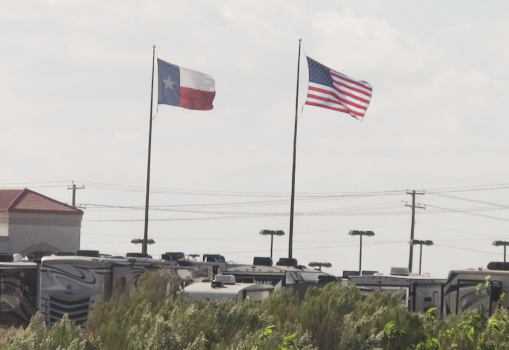
Good night!
Zitiert in: Dossenheim to Malta on Rails Saner Timestamps With DIT: In Pelican and Beyond Mach mit bei DIT Boston-Tucson on Amtrak: Day 4 Boston-Tucson on Amtrak: Day 2
![[RSS]](./theme/image/rss.png)